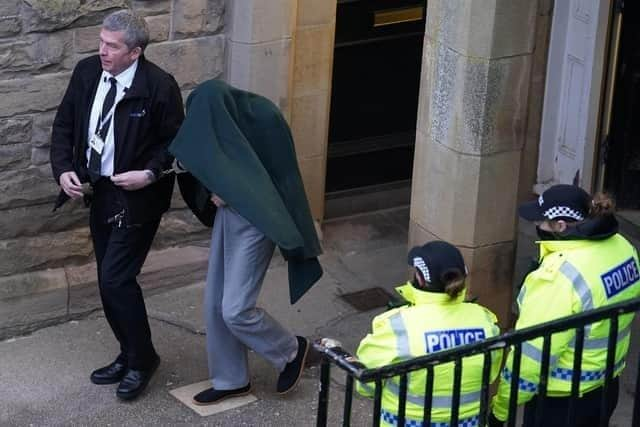Why the Andrew Miller case calls into question the judgement of Shona Robison on gender self ID - Euan McColm
While opposition members and feminist campaign groups raised concerns that allowing men to self-identify as women could undermine the safety of single-sex spaces, such as refuges and changing rooms, Robison had no such worries.
There was, she said, no evidence of predatory men pretending to be anything other than themselves in order to abuse women and girls.
Advertisement
Hide AdAdvertisement
Hide AdThe horrifying case of Andrew Miller, jailed last week for 20 years for kidnapping and repeatedly sexually assaulting a schoolgirl, makes Robison – now deputy first minister – look naive at best.


Miller, who is in the process of transitioning and has lived as Amy George for a number of years, was dressed as a woman when he offered his victim a lift in the Scottish Borders in February. Rather than taking the child, who was not known to him, home to her family, Miller drove to his bungalow, where he sexually assaulted her over a 27-hour period. The girl’s ordeal only came to an end when Miller – the 53-year-old proprietor of a butcher’s shop in Melrose – fell asleep and she was able to call police.
The judge’s sentencing remarks in Miller’s case make for distressing reading.
Lord Arthurson described the predator’s offences as “abhorrent crimes” of the utmost "deviance and depravity”, which had had an “incalculable” impact on his young victim and her family.
The judge said the “mode of abduction” was a “significantly aggravating” feature of the crime. “I'm referring,” said Lord Arthurson, “to your female presentation. Would a girl have willingly entered your car if you had presented as a man?”
After his arrest, Miller told police he had treated the child in a “motherly” way and talked in detail about wanting to limit the impact of his crimes on the “wider trans community”.
The victim? Well, Miller tried to place responsibility for his actions on her, a schoolgirl emotionally scarred for life.
After Miller’s sentencing, Robison was asked by journalist Connor Gillies of Sky News whether she stood by the remarks she made last year.
Advertisement
Hide AdAdvertisement
Hide AdThe vast majority of trans people, she replied, just want to get on with their lives. What we were talking about here was someone who had committed very serious crimes. Anyone who has committed an offence was an offender and should be treated as such.
When Gillies pointed out to Robison that Miller was dressed as a woman when he lured his victim into his car, she replied that he was “clearly a predatory man”.
Robison said we should not allow cases such as the one involving Miller to imply there’s an issue for the rest of the trans community.
But campaigners against reform of the GRA have not suggested the entire trans community should be viewed as offenders. Rather, they have warned that allowing men to self-ID as women and giving them access to single-sex safe spaces may be dangerous.
They agree with Robison that Miller is a predatory man. And they don’t think making it easier for predatory men to gain access to facilities provided for women and girls is a sensible thing to do.
Miller’s case is unusual – as was the case of rapist Adam Graham, who began identifying as Isla Bryson and was sent to a female prison in January before public outrage forced ministers to intervene and have him moved to a male facility. But can we ignore the issues it presents?
Can Robison stand by her claim there’s no evidence of predatory men pretending to be anything other than themselves in order to attack women and girls?
Does her insistence that Miller is a predatory man and not a trans woman square things off?
Advertisement
Hide AdAdvertisement
Hide AdNo, I’m afraid it doesn’t. The Scottish Government’s self-ID policy makes clear that when someone tells us they are a woman (or a man) we must simply believe them.
Miller has spent the past eight years telling the world he is a woman. There is no clause in the proposed reform of the GRA that provides an exemption for the Andrew Millers of this world.
It is undoubtedly the case the majority of trans women – like the majority of men – do not commit crimes such as those of Graham and Miller. The question, then, is how many such crimes do we deem to be acceptable before we question whether the self-ID proposal is wise?
You may say that law-abiding trans women should not be excluded from single-sex spaces on the basis of the crimes of Graham and Miller. Others may think that, just as we agree men of good character should be excluded from such spaces as a matter of course, so should anyone not born female, no matter how they now identify.
MSPs voted last year in favour of reforming the GRA but, so far, this legislation has not been put into the statute books.
Secretary of State for Scotland Alister Jack intervened to block the change in the law on the grounds that it was not compatible with the UK-wide Equality Act.
The Scottish Government is currently challenging that intervention in court. The SNP wishes us to believe that Jack has launched an unprecedented attack on Scottish democracy.
However, the majority of Scots do not support self-ID. Among their number are SNP politicians who believe the implications of reforming the Gender Recognition Act are serious.
Advertisement
Hide AdAdvertisement
Hide AdRobison is perfectly entitled to continue to support the introduction of self-ID, but she should be honest enough to concede such a move would make it easier for men like Miller to gain access to spaces where vulnerable women and girls should feel safe.